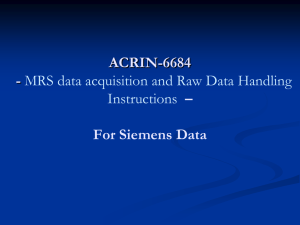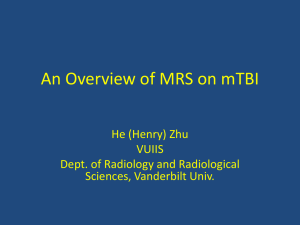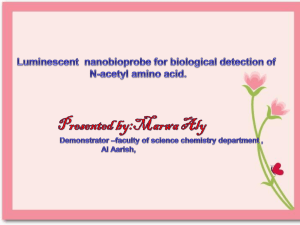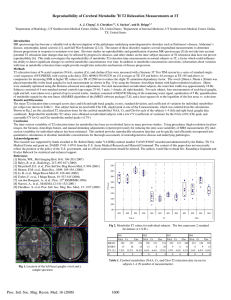Clinical Applications of magnetic resonance spectroscopy
advertisement
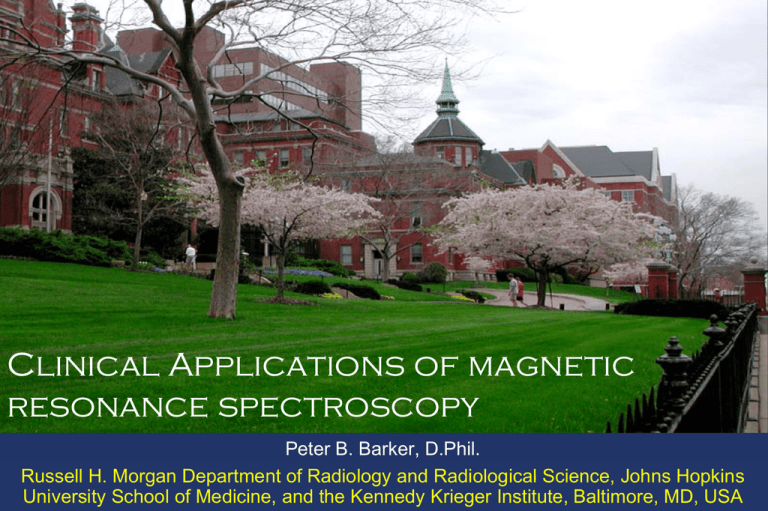
Clinical Applications of magnetic resonance spectroscopy Peter B. Barker, D.Phil. Russell H. Morgan Department of Radiology and Radiological Science, Johns Hopkins University School of Medicine, and the Kennedy Krieger Institute, Baltimore, MD, USA Information Content of Proton Brain Spectra Compounds detectable (at either long or short echo times): Normal NAA Cho Cr • N-Acetyl Aspartate (NAA): Axons, neurons, dendrites • Creatine + Phosphocreatine (Cr): Energy metabolites • Cholines (Cho): TE 280 ms Ischemic Brain Lac Glial cells, active demyelination • Lactate (Lac): Anaerobic glycolysis, ischemia PPM 4.0 3.0 2.0 1.0 Compounds detectable at short echo times (< ~35 ms) • • • Myo-inositol (mI) - glial cells, demyelination, osmolyte (?) Glutamate + Glutamine (Glx) Lipids NAA TE = 35 msec Cho Cr mI “Glx” Lipids PPM 4.0 3.0 2.0 1.0 • Other Compounds normally • present (if you look closely!) • NAAG, Aspartate • Taurine, Scyllo-Inositol • Betaine, Ethanolamine* • Purine Nucleotides* • Histidine* • Glucose (Glycogen?) • Compounds observed using “Spectral Editing” • GABA • • Ascorbic acid • Glutathione • ‘Macromolecules’ * * - Short TE only Compounds which may be detectable under abnormal/pathological conditions • β-Hydroxy-butyrate, acetone • Phenylalanine (PKU) * • Galactitol, Ribitol, Arabitol • Succinate, pyruvate • Alanine • Glycine • Valine, leucine, isoleucine • Threonine? Exogenous Compounds • Propan-1,2-diol • Mannitol • Ethanol • MSM - methylsulfonylmethane The Developing Brain: Parietal White Matter Kreis et al. MRM 30: 424-437 (1993) Occipital Gray Matter Normal Aging 30 year old 69 year old NAA Putamen Cho Cho Cr Cr Frontoparietal Gray Matter PPM 4.0 3.0 NAA Putamen Frontoparietal Gray Matter 2.0 1.0 PPM 4.0 3.0 2.0 1.0 Normal Aging: mM Concentrations 14 * * * ‡ 10 NAA Cho 6 2 20-40 (N=20) 4 >65 yrs (N=20) * 3 * * * * ‡ * 2 1 1 2 3 4 5 6 ISMRM 2002. #1318 Horska et al. 7 8 9 10 11 12 BRAIN REGION 13 14 15 16 17 * significant effect of age p<0.05 ‡ p<0.06 Neurobiol Aging. 2009 Mar;30(3):353-63. Epub 2007 Aug 23. MR Spectroscopic Imaging (MRSI) T1 Cho Gray Matter Frontal White Matter NAA NAA - Lateral ChoCr Cho Cr Frontal Gray Matter - Mesial Semiovale Centrum Cr NAA Posterior Gray Matter - Lateral Parietal White Matter Posterior Gray Matter - Mesial PPM 4.0 3.0 2.0 1.0 MRSI in the brainstem and cerebellum T1 MRI 3 2 1 3 Pons Cerebellar Hemisphere 2 Vermis 1 Cho Cr NAA 7 Tesla 2D SENSE MRSI NAA NAA Cr GSH/MM Cr Cho NAA Glx mI Glu Asp Gln Tau PPM 4.0 3.0 2.0 1.0 32-channel Multi-slice 2D-MRSI, 0.7 cm3, SENSE=2x1.5, TE=34ms, 7x7x15 mm, ~13 min All of the following metabolites may be detected in long echo time proton spectroscopy of the brain except: 0% 0% 0% 0% 0% 1. 2. 3. 4. 5. Choline Phosphocreatine Lactate Myo-Inositol Glycine 10 Answer: All of the following metabolites may be detected in long echo time proton spectroscopy of the brain except: 1. Choline 2. Phosphocreatine 3. Lactate 4. myo-inositol 5. Glycine In vivo proton MR spectroscopy of the human brain. Barker PB, Lin DD. Prog NMR Spect 2006;49:99-128 During the 1st 2 years of life, the following metabolic changes occur in the brain 0% 0% 0% 0% 0% 1. 2. 3. 4. 5. NAA and choline increase NAA increases and myo-inositol decreases NAA increases, and choline and creatine decrease NAA and creatine increase Lactate increases 10 Answer: During the 1st 2 years of life, the following metabolic changes occur in the brain a. NAA and choline increase b. NAA increases and myo-inositol decreases c. NAA increases, and choline and creatine decrease d. NAA and creatine increase e. Lactate increases Development of the human brain: in vivo quantification of metabolite and water content with proton magnetic resonance spectroscopy. Kreis R, Ernst T, Ross BD. Magn Reson Med. 1993;30(4):424-37 In the normal adult brain, which of the following is true? 0% 1. 0% 2. NAA/creatine ratio is higher in gray matter than white matter Choline is higher in posterior brain regions than frontal 0% 3. The brain stem has high levels of creatine 0% 4. 5. The cerebellum has high levels of creatine Deep and cortical gray matter have the same spectral appearance 0% 10 Answer: In the normal adult brain, which of the following is true? a. NAA/creatine ratio is higher in gray matter than white matter b. Choline is higher in posterior brain regions than frontal c. The brain stem has high levels of creatine d. The cerebellum has high levels of creatine e. Deep and cortical gray matter have the same spectral appearance Mapping of brain metabolite distributions by volumetric proton MR spectroscopic imaging (MRSI). Maudsley AA, Domenig C, Govind V, Darkazanli A, Studholme C, Arheart K, Bloomer C. Magn Reson Med. 2009;61(3):548-59 Normal Brain Astrocytoma Gr II Choline Metabolic Pathways All Cases, r2 = .32 GBM only, r2 = .76 Glioblastoma Multiforme (High Grade Tumor) FLAIR Cho Right T1 Cho Cr NAA NAA Lac Left PPM 4.0 3.0 2.0 1.0 Riedy and Barker ASNR Washington DC 2003 Glioblastoma Multiforme (High Grade Tumor) FLAIR Cho Cr NAA Cho T1 Post-Gd NAA Cr Cho NAA Cr PPM 4.0 3.0 2.0 1.0 PPM 4.0 3.0 2.0 1.0 Riedy and Barker ASNR Washington DC 2003 Oligodendroglioma - (Grade II) FLAIR R. Contralateral NAA Cho Cr L. Lesion PPM 4.0 3.0 2.0 1.0 Riedy and Barker ASNR Washington DC 2003 Brain Tumor Metabolite Concentrations (milliMolar) Choline NAA 6.0 10.0 9.0 5.0 8.0 7.0 4.0 6.0 3.0 5.0 4.0 2.0 3.0 2.0 1.0 1.0 0.0 0.0 Oli 2 Ast 2 Oli 3 GBM GBM GBM GBM Oli 2 Ast 2 Oli 3 GBM GBM GBM GBM LESION CONTRALATERAL Riedy and Barker ASNR Washington DC 2003 (pure and mixed) astrocytomas (INN Besta n=58) Dr Alberto Bizzi, Instituto Neurologica Carlo Besta’, Milan, Italy Outlier G.A. - 64 H-MRSI T1-wi pre-Gd Cho Cr T2-wi NAA Lip T1-wi post-Gd Dr Alberto Bizzi, Instituto Neurologica ‘Carlo Besta’, Milan, Italy G.A. - 64 H-MRSI Outlier Oligo WHO II colorazione EE T2WI Brain Tumor Diagnosis F.A. Howe et al., Magnetic Resonance in Medicine 49:223–232 (2003) Brain Tumor Diagnosis Lactate + Alanine + Lipids F.A. Howe et al., Magnetic Resonance in Medicine 49:223–232 (2003) Brain Lesion Diagnosis: Malignant vs. Benign Hypotheses: • Benign lesions will have lower Cho than malignant • Benign lesions will have lower rCBV than malignant • Combined measurement of Cho and rCBV will have higher sensitivity/specificity than either alone Hourani, Horská, Barker et al. AJNR 2008;29(2):366-372 Primary CNS Lymphoma FLAIR T1+ Gd rCBV 1.Right parietal NAA Cho Cr 1 Cho 2 Cr NAA 2. Lesion PPM 4.0 3.0 2.0 1.0 Meningoencephalitis 1.Right frontal NAA FLAIR 1 T1+ Gd rCBV 2 Cho Cr Cho Cr NAA 2. Lesion PPM 4.0 3.0 2.0 1.0 Results - Sensitivity and Specificity Discriminant function analysis MRSI: Perfusion: 93.3% correct 80.0% correct Cut-off value analysis: NAA/Cho < 0.61 84.1% sensitivity, 86.1% specificity rCBV > 1.5 77.8% sensitivity, 91.7% specificity Area under curve 0.86 0.92 0.96 Combined MRSI+PWI 72.2% sensitivity, 91.7% specificity Hourani, Horská, Barker et al. AJNR 2008;29(2):366-372 But there are still outliers.. infiltrating, low grade glioma FLAIR Cho Cr Contralateral NAA Cho Cr CBV NAA T1+Gd Lesion PPM 4.0 3.0 2.0 1.0 F 3 yr old, complex partial seizures Tumefactive MS Lesion Cho FLAIR NAA CBV Lesion Cho Lac T1 Post Gd Lac PPM 4.0 3.0 2.0 1.0 41 year old male Which of the following statements is false? 0% 2. The level of Cho generally increases with the increasing grade of a glial brain tumor Lipids are elevated in glioblastoma multiforme 0% 3. Lipids are elevated in metastatic brain tumors 0% 4. myo-Inositol is elevated in anaplastic astrocytoma 0% 5. N-acetyl aspartate in decreased in all brain tumors 0% 1. 10 Answer: Which of the following statements is false? a. The level of Cho generally increases with the increasing grade of a glial brain tumor b. Lipids are elevated in glioblastoma multiforme c. Lipids are elevated in metastatic brain tumors d. myo-Inositol is elevated in anaplastic astrocytoma e. N-acetyl aspartate in decreased in all brain tumors Correlation of myo-inositol levels and grading of cerebral astrocytomas. Castillo M, Smith JK, Kwock L. AJNR Am J Neuroradiol. 2000 Oct;21(9):1645-9 Which of the following features can be used to reliably distinguish tumefactive demyelinating lesions from glioblastoma multiforme (GBM) 0% 0% 0% 0% 0% 1. 2. 3. 4. 5. Low NAA High Cho High lactate High lipid None of the above 10 Answer: Which of the following features can be used to reliably distinguish tumefactive demyelinating lesions from glioblastoma multiforme (GBM) a. Low NAA b. High Cho c. High lactate d. High lipid e. None of the above Intra-axial brain masses: MR imaging-based diagnostic strategy--initial experience. Al-Okaili RN, Krejza J, Woo JH, Wolf RL, O'Rourke DM, Judy KD, Poptani H, Melhem ER. Radiology. 2007;243(2):539-50 Effects of Treatment: Radiation Necrosis vs. Tumor Recurrence Tumor Regrowth/ Radiation Necrosis Normal Brain Necrosis Recurrent Tumor Preul et al. Can. J. Neurol. Sci. 1998; 25: 13-22 Radiation Necrosis Rock JP, Hearshen D, Scarpace L, Croteau D, Gutierrez J, Fisher JL et al. Correlations between magnetic resonance spectroscopy and image-guided histopathology, with special attention to radiation necrosis. Neurosurgery 2002; 51:912-9; discussion 919-20 Recurrent Tumor FLAIR NAA FDG Cho Lac Radiation Necrosis 2/99 Pre-treatment Pre-treatment Post-treatment 3/00 Post-treatment T1 R. Frontal Anaplastic Astrocytoma Cho Post-treatment PET Courtesy of Dr David Hearshen, Henry Ford Hospital, Detroit, MI Astrocytoma - Recurrent tumor or Radiation Necrosis? FLAIR T1 Post Gd A Cho Cr A NAA C B B * Lipid * Cho NAA C PPM 4.0 3.0 2.0 1.0 Astrocytoma - FDG-PET/CT MRS in Brain Tumors: Summary • Diagnosis - overlap • Tumor Grading – low vs. high • Malignant vs. Benign • Evaluation of treatment response • Comparison to other modalities (PWI/PET) “Mitochondrial Diseases” - disorder of TCA cycle metabolism • Heterogeneous group of inherited disorders • Manifest in childhood or early adulthood • Effect muscle, brain, optic and other organ systems • Often associated with lactic acidosis • Definitive diagnosis can be difficult in some cases Mitochondrial Encephalopathy with Lactic Acidosis and Stroke like Episodes (MELAS) Lin, Crawford and Barker, AJNR 24; 33-41 (2003) Methylmalonic Acidemia (M 14 yrs, mut-) Isoleucine, valine, threonine Proprionic acid Methylmalonic acid Methylmalonyl CoA mutase, Adenosyl cobalamine Succinate Trinh, Melhem and Barker, AJNR Am J Neuroradiol 22:831–833, 2001 Complex II (Succinate Dehydrogenase) Deficiency T2 Succ White Matter Cr Cho NAA Lac PPM Succ PPM 3.0 3.0 2.0 2.0 1.0 1.0 Gray Matter PPM PPM 3.0 3.0 2.0 2.0 1.0 1.0 Provided by Dr Alberto Bizzi, Istituto Nazionale Neurologico “Carlo Besta”, Milan, Italy Lactate Elevation in Suspected Mitochondrial Disease • 63% sensitivity, high (~100%) specificity in some studies, depending on inclusion/exclusion criteria* • Lactate often highest (or only seen) in ventricular CSF • May depend on stage of disease • Lactate best visualized on long TE (e.g. 140 or 280 msec) MRS *Lin, Crawford and Barker, AJNR 24; 33-41 (2003) Which of the following statements about mitochondrial diseases (MD) is true? 0% 1. Lactate is best detected in ventricular CSF 0% 2. Lactate is best detected in the brain 3. Lactate is always seen in brain lesions associated with MD, but not normal appearing brain Lactate is only elevated in mitochondrial diseases, and not other metabolic diseases Brain lactate levels are well correlated with serum lactate levels 0% 0% 4. 0% 5. 10 Answer: Which of the following statements about mitochondrial diseases (MD) is true? a. Lactate is best detected in ventricular CSF b. Lactate is best detected in the brain c. Lactate is always seen in brain lesions associated with MD, but not normal appearing brain d. Lactate is only elevated in mitochondrial diseases, and not other metabolic diseases e. Brain lactate levels are well correlated with serum lactate levels Cerebral lactic acidosis correlates with neurological impairment in MELAS. Kaufmann P, Shungu DC, Sano MC, Jhung S, Engelstad K, Mitsis E, Mao X, Shanske S, Hirano M, DiMauro S, De Vivo DC. Neurology. 2004;62(8):1297-302 Summary – MRS in Metabolic Diseases • Some rare diseases have specific, pathognomic metabolic patterns • Succinate dehydrogenase • Creatine deficiency • Non-ketotic hyperglycinemia • Leukodystrophies, others… • More commonly non-specific metabolic changes related to underlying tissue pathophysiology • NAA decreased – neuroaxonal loss/dysfunction • Cho elevation in active demyelination • Lactate increased in anaerobic glycolysis Acknowledgments Johns Hopkins/Kennedy Krieger Inst. Tom Crawford Alena Horská Roula Hourani Doris Lin Marty Pomper Gerard Reidy Peter van Zijl Istituto Carlo Besta, Milan, Italy Alberto Bizzi


